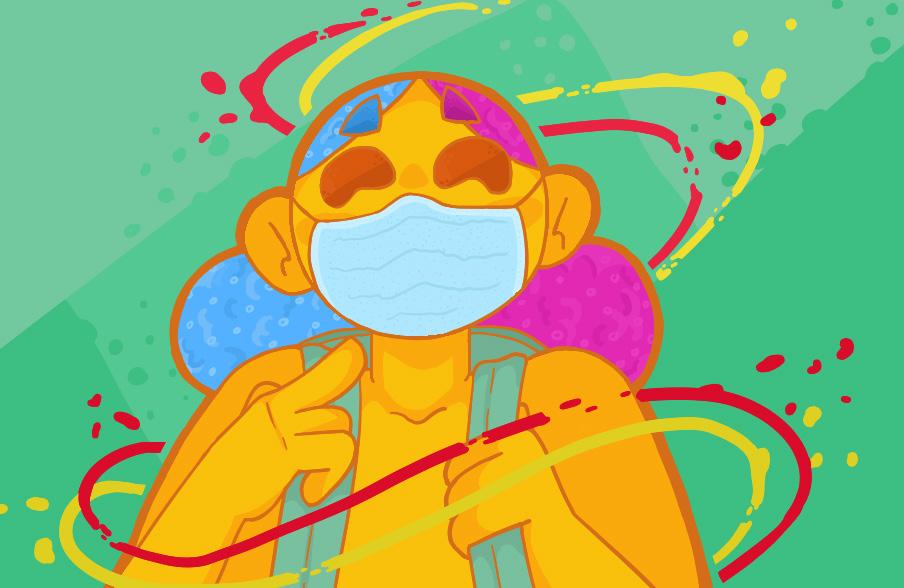
4 minute read
NEWS
Hybrid’s happening
At the start of second semester, MCHS’s hybrid schedule begins along with new changes
Advertisement
Kiera Loewe Social Media Director
Starting second semester, students have the option to remain remote or begin hybrid learning. Regardless of what option a family chooses, students will need to adjust to new schedules, new guidelines, and new feelings.
With District 156 starting hybrid learning on January 20, students should expect a much different school setting due to the safety precautions that have been put into place.
Students who have chosen hybrid learning should expect to see changes such as: wearing masks, social distanced desks, four minute passing periods, limited locker use, and more. The MCHS Second Semester 2021 Hybrid Learning plan is designed so that, on “face-to-face days,” students can connect with teachers and classmates in a COVID-friendly way.
“Schools have been shown to be not major spreaders of the virus and we will continue to practice all the best safety guidelines,” reports Assistant Superintendent of Curriculum and Instruction Carl Vallianatos.
Students will still be expected to complete work asynchronously on their “off days,” be they “orange” or “black.”
The decision to go back has been pushed by many students, staff, and parents, many of which are having difficulties with remote learning and are eager to go back.
“I am excited to go back to school partially in person because so much of what makes school tolerable is the social aspect of it,” sophomore Taylor Wickenkamp explained. “I hope this will be a step towards ‘normal’ and helps any students that have been struggling over online school get back on track.”
“We look forward to students having face-to-face contact with teachers twice a week,” added Vallianatos, “so that they can build connections again in person and participate in hands-on activities, labs, and other experiences difficult to replicate remotely."
Those who have signed the waiver will continue remote learning until after spring break, at which point they will then have the option to switch to hybrid if they can.
“I’ve decided to continue to do remote learning because I believe it’s what’s best for my family,” tells sophomore Mara Torres. “I know that the school is going to do everything in their power to keep everyone safe and healthy, but taking into consideration the amount of households present, I don’t think that would be the most educated option for me personally.”
The students that choose remote will log on at 7:35 a.m. and go to all 8 classes on their designated day, so they are on the same schedule as hybrid students.
Students should familiarize themselves with the plan to prepare for the upcoming transition.

Patient receives COVID-19 vaccine shot in Anchorage, AL. Frontline health workers were the first scheduled to receive the two COVID injections, which need to spaced several weeks apart.
Distribution of COVID-19 vaccines begins
With two promising coronavirus vaccines, the CDC outlines phases in which people will receive the vaccination
Joe Ndu
Ever since the pandemic quarantined America, we have been waiting for something that would get us back to some semblance of normal. That hope is slowly becoming a reality as the COVID-19 vaccine had begun to be distributed across the country.
A vaccine must go through various stages of testing and research before it can be approved for use by the public, the first of which is the exploratory stage. This stage is the start of lab research and usually lasts 2 to 4 years. However, during the race to find a cure for COVID-19, scientists produced safe and effective vaccines in record time.
The FDA gave authorization to Pfizer-BioNTech’s vaccine on December 11, 2020. A week later, the same authorization was given to the Moderna vaccine.
Both vaccines have shown over 90% efficacy, or the ability to produce intended results. They require two doses which are to be administered several weeks apart. Both vaccines have currently Staff Reporter been authorized by the CDC in the United States to treat COVID-19 and have begun to be distributed across the country to people the CDC designated under Phase 1.
The CDC recommends that under Phase 1A of vaccine distribution, healthcare workers and residents of long-term care facilities should receive the vaccine first. This will help to prevent further spread of the virus, decrease death rates due to COVID-19, and reduce the already heavy burden on the healthcare system.
Phase 1B states that people older than 75 and essential frontline workers, including first responders, education professionals, food and agriculture plan employees, manufacturing employees, corrections officers, US postal service workers, grocery store workers, and public transit workers, should receive the vaccine.
Phase 1C includes people 65 or older, those with underlying medical conditions with increased risk of serious, life-threatening complications under COVID-19, and all other essential workers.
Phase 2, which is the most recent of these phases, proposes a massive vaccination campaign for all people aged 16 or older.
Doctor Anthony Fauci states that 70 to 80 percent of the U.S. population needs to be vaccinated in order to achieve herd immunity. “Once you get rolling and get some momentum, I think we can achieve 1 million a day or even more,” Fauci said.
Photo By: Steven Cornfield / Unsplash



